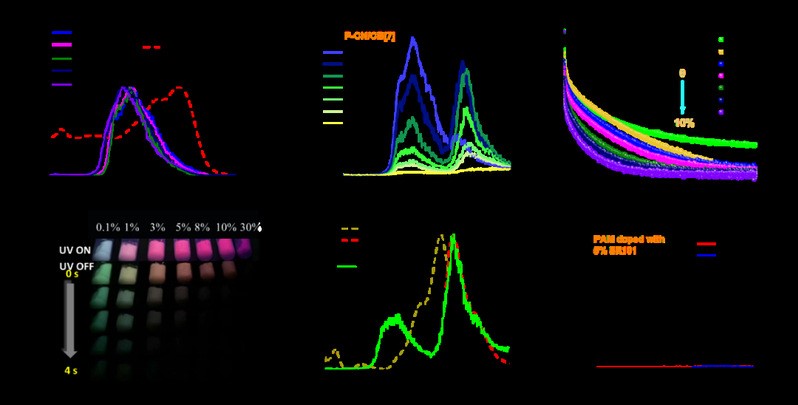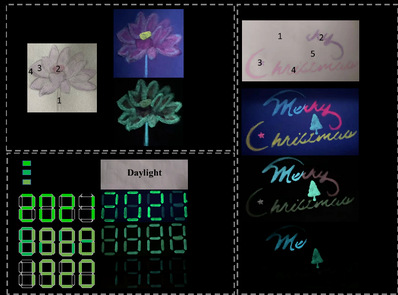Work of Prof. Yu Liu’s Research Group Published on Angew: Tunable Second-Level Room-Temperature Phosphorescence of Solid Supramolecules and Phosphorescence Energy Transfer
Purely organic phosphors, with its excellent bio-compatibility, convenience for modification, superior long-lived emission and afterglow, have attracted widespread attention in fields of bioimaging, sensors, photoelectric materials, anti-counterfeiting field, and so forth. In recent years, Prof. Yu Liu’s Research Group of Nankai University found 4-phenylpyridinium derivatives with various substituent groups and cucurbituril exhibiting room-temperature phosphorescence, and carried out a series of research. They were therefore invited to publish several reviews on Accounts of Chemical Research(Acc. Chem. Res. 2021, 54, 3403-3414.), in which high quantum yield and long-lived room-temperature phosphorescence (Angew. Chem. Int. Ed. 2019, 131, 6089-6093; Chem. Sci., 2019, 10, 7773-7778.), synergistically enhanced room-temperature phosphorescence(Angew. Chem. Int. Ed., 2020, 59, 18748-18754.), folded/extended molecular room-temperature phosphorescence( Adv. Mater. 2021, 33, 2007476; Adv. Sci. 2021, 2103041.), water-phase phosphorescence and its application in targeted phosphorescence imaging and phosphorescence energy transfer(J. Am. Chem. Soc. 2021, 143, 13887-13894; Nat. Commun., 2020, 11, 4655; Angew. Chem. Int. Ed. 2021, DOI: 10.1002/anie.202113577; Small, 2021, DOI: 10.1002/smll.202104514; Chem. Sci., 2021, 12, 1851)were introduced. Recently, the group made another great breakthrough in the study of regulation long life phosphorescence and delayed photoluminescence, and their work has been published on Angew. Chem. Int. Ed.( DOI: 10.1002/anie.202115265).
Based on preliminary works, tunable second-level room-temperature phosphorescence and high-efficiency phosphorescence energy transfer, as well as delayed phosphorescence emission (fig. 1) was successfully realized through a substituent group effect (P−R: R=−CN, −CO2Et, −Me, −CF3) and a host–guest complexation effect between 4-phenylpyridinium derivatives and cucurbitu[7]ril(CB[7]). 4-phenylpyridinium derivatives with various substituent groups were copolymerized with acrylamide through radical binary copolymerization to produce the corresponding copolymers. Benefiting from large amount of hydrogen bonds and carbonyl groups provided by the acrylamide copolymer, fast intersystem crossing (ISC) process of excitons in chromophores were efficiently promoted, while the nonradiative decay highly suppressed, so that different polymers were capable of giving good phosphorescence emission under room temperature. Interestingly, 4 types of polymers exhibited various second-level lifetime due to the difference in substituents (including 0.9 s, 1.0 s, 1.3 s, 1.6 s, 1.7 s, 1.9 s and 2.2 s). Moreover, the range of lifetime could be further extended (up to 0.9 s, 1.3 s, 1.9 s, 2.2 s)by introducing CB[7], especially P-CF3/CB[7], by which the lifetime was extended to 2.2s. These various ultralong RTP emissions almost covered the entire range from 0.9 s to 2.2 s. Therefore, by skillfully combining substituent effect and host-object interaction, Prof. Yu Liu's group successfully achieved the regulation of phosphorescent lifetime on second-level, which made it possible to precisely regulate emission of second-level phosphorescence.

Figure 1. a) The various ultralong lifetimes realized by this work. b) The schematic illustration of tunable second-level room-temperature phosphorescence based on supramolecular polymer
In addition to long-life phosphorescence, delayed fluorescence with long life has recently shown great application prospects in the fields of biological imaging and photoelectric materials, thus attracted much attention. As an effective method for delayed fluorescence, phosphorescence energy transfer has been studied extensively. The group therefore wondered if the supramolecular polymer could be used as a phosphorescent donor to achieve ultra-long phosphorescent energy transfer.
The effect proved evident in the result. Ternary supramolecular systems constructed by different supramolecular polymers and dye receptors (EY and SR101) exhibited excellent energy transfer efficiency (calculated as high as 68.9 % ) and ultra-long delayed fluorescence emission.(fig. 2) In addition, they also found that the delayed fluorescence emitted by the phosphorescent energy transfer system can be significantly captured by the naked eye after the 254 nm light source is turned off, indicating the characteristics of the long lifetime of the delayed fluorescence. More interestingly, the color (EY: yellow, SR101: pink) and lifetime of delayed fluorescence can be effectively regulated by changing the type and ratio of supramolecular donor and dye receptor. Based on this, the multicolor delay luminescence material has been applied to information security, digital encryption, multicolor luminous copywriting, etc., reflecting the wide application of adjustable second-level room temperature phosphorescence and ternary molecular phosphorescence energy transfer system in information encryption, security and other fields (Fig. 3).

Figure 2. a) The overlapped solid UV/Vis spectra of donor and receptor molecules; b) delayed spectra and d) luminescence photographs; c) time-resolved decay spectra of P−CN/CB[7] at 504 nm with increasing molar ratio of receptors; e) the photophysical properties of doped receptor in the ternary supramolecular system; f) delayed spectra of doped receptor.

Figure 3. Luminous pigments, digital encryption and multi-color luminous copywriting design
The works were recently published in Angew. Chem. Int. Ed. The first author is Dr. Wenwen Xu of Nankai University.
About the Tutor
Prof. Dr. Yu Liu: https://www.x-mol.com/university/faculty/11804
Group website: https://supram.nankai.edu.cn/
Article Information
Wen-Wen Xu, Yong Chen, Yi-Lin Lu, Yue-Xiu Qin, Hui Zhang, Xiufang Xu, and Yu Liu,Tunable Second-Level Room-Temperature Phosphorescence of Solid Supramolecules Between Acrylamide-Phenylpyridium Copolymers and Cucurbit[7]uril,Angew. Chem. Int. Ed.,2020,DOI: 10.1002/anie.202115265
Link to the full text: https://onlinelibrary.wiley.com/doi/10.1002/anie.202115265

